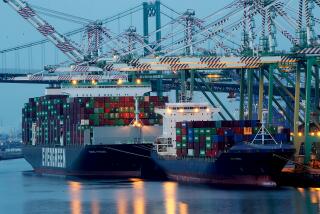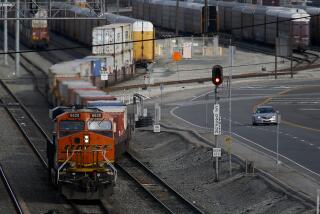Port Air Cleanup Plan May Become a Model
When Noel Park tells the story of why he sued the Port of Los Angeles -- and how that lawsuit secured a $60-million settlement -- he thinks back to the map.
He recalls the eerie blue shadow covering the coast from Palos Verdes to Orange County, the blue smudge extending nearly halfway to Catalina.
“There are certain things you remember in your life in Technicolor,” he said. “I went, ‘Oh, my God!’ ”
The azure blue on the color-coded map showed those areas of the Los Angeles region most at risk for cancer caused by air pollution. To Park’s alarm, the blue tint was brilliant along the southern coast of Los Angeles County, a distinction that air-quality regulators blame largely on diesel exhaust from the port.
Park and his San Pedro neighbors went to court. In a classic David-and-Goliath showdown, they reached a settlement that requires the port to take significant steps to reduce diesel exhaust.
That settlement represents a power shift. For decades, the port expanded with few major challenges. Nearby residents fed up with air pollution and noise typically resorted to letter writing and making phone calls. This time, they stunned port officials in court by temporarily halting the opening of a $47-million terminal built for one of the port’s most valued tenants.
The talks that ensued produced a pact that port officials and environmental attorneys are hailing as a milestone, a “win-win” they say will benefit air quality and the regional economy alike.
Several forces converged to create that pact.
First, research in the last five years has underscored the potentially serious effects of diesel exhaust on human health. Residents in some port cities -- from Oakland to Houston -- have begun recognizing that port operations can contribute significantly to air pollution.
*
Election Changes
In Los Angeles, they were aided by the 2001 election of Mayor James K. Hahn and his sister, Councilwoman Janice Hahn, San Pedro residents who have expressed concern about diesel exhaust.
At the same time, ports nationwide have begun experimenting with new technology to cut diesel emissions.
The recent settlement could place Los Angeles in the forefront of that effort, some experts say. It may become the first port in the nation to regularly supply cargo ships with electricity so they can turn off their diesel engines while in port.
“They’ve agreed to a number of innovative practices that will allow the industry to see how viable they are,” said Tom Chase, director of environmental affairs at the American Assn. of Port Authorities.
The pact ends a lawsuit brought nearly two years ago by residents and environmental groups, challenging the approval of a 174-acre terminal for China Shipping Holding Co.
The groups contended that the port failed to prepare an environmental review as required by state law. A state Court of Appeal panel agreed with that claim last October, ordering construction halted while the port conducted an environmental impact report -- a process that can take many months. The terminal was 90% complete at the time.
The shutdown gave residents the upper hand. In the competitive world of global trade, the Port of Los Angeles did not want to lose an important customer such as China Shipping to another port. The settlement allows the terminal to be completed in a matter of weeks. For Noel Park, the story isn’t over.
“There are 80,000 people in San Pedro, and they’re all from Missouri -- the ‘Show Me State,’ ” said Park, who has lived near the port since 1965.
Park and his neighbors have tussled with port officials over environmental issues for decades.
This time, however, they were armed with a landmark report issued in 1999 by the South Coast Air Quality Management District, reviewing air pollution in the Los Angeles Basin and the potential cancer risk it poses.
The study found that 71% of the cancer risk from toxic air pollution in the Los Angeles Basin is caused by diesel exhaust from ships, trucks and other sources.
The potential cancer risk was found to be highest along freeways, in the Los Angeles-Long Beach port area and in a wide band from central Los Angeles to the county’s southern border.
The map showing that risk -- with its vivid blues -- startled residents who had assumed that living near the coast meant clean air.
“That was a real revelation to a lot of people,” Janice Hahn recalled.
It put the issue of diesel front and center for Park, who first saw the map in 2000 at an air district meeting.
Park and his neighbors handed out the map at meetings. They mailed it to local officials and congressmen. One group even mounted it on an easel during a mock funeral for victims of diesel exhaust.
“I’ve had people in San Pedro tell me, ‘Stop handing out those maps. It’s going to hurt our property values,’ ” Park said. His response: “The way to improve our property values is to clean it up.”
But the air at U.S. ports, unlike the water, has not been covered by strict regulations. Their heaviest polluters -- ships, trains, trucks and yard equipment -- are considered mobile sources that are not subject to the same strict federal regulations that govern factories and power plants.
Ships are the worst offenders, burning vast amounts of a low-grade, high-sulfur “bunker fuel.” On an average day, 16 ships arrive at Los Angeles and Long Beach, releasing more pollution than a million cars. Most of the ships are foreign-flagged and, hence, not subject to federal laws.
Yet public concern is growing, and some ports are responding.
In Oakland, residents of a low-income neighborhood sued the local port over expansion plans, winning a settlement that helped produce $9 million in improvements to reduce emissions. In Juneau, Alaska, Princess Lines cruise ships can now turn off their diesel engines in port and plug in to shore power.
In Los Angeles, Mayor Hahn has vowed that there will be no net increase in air pollution at the port. During a trip to Asia last fall, he obtained agreements from half a dozen shipping companies to participate in a plug-in power program. Companies also agreed to burn a diesel fuel with less polluting sulfur.
But as recently as two years ago, Park and his neighbors felt shunted aside when they tried to learn how the China Shipping terminal might affect air quality.
In May 2001, they asked the City Council not to approve the project until an environmental review was completed. Their five speakers were allotted a total of five minutes to speak, further frustrating the residents. One speaker barely had time to show the cancer-risk map. The council still approved the project.
So residents sought out a lawyer. They found Gail Ruderman Feuer, a staff attorney at the Natural Resources Defense Council with a national reputation for winning tough air pollution cases. She and a colleague, Julie Masters, worked on the case for nearly two years.
Feuer, too, turned to the map of cancer risks, submitting it to the judges overseeing the case. Feuer remembers that even she was surprised by how bands of bright blue outlined the freeway corridors.
Some port officials remain skeptical when reminded of that map.
Larry A. Keller, the port’s executive director, noted that the 1999 study relied in part on computer modeling rather than strict field sampling. He also said that his staff already was planning significant improvements in air quality before the legal settlement.
“We’ve been very proactive,” he said. “I’m very, very proud of our environmental staff here.”
The new pact earmarks $50 million to offset port impacts on the communities of Wilmington and San Pedro. The remaining $10 million will go to a project promoting the trade-in of old diesel trucks for cleaner-burning models.
As part of the pact, China Shipping could become the first “plug-in” cargo terminal in the nation. The settlement calls for the port to spend up to $5 million to retool China Shipping vessels so that they can use electricity while in port.
*
Wise Investment
The cost of the settlement is expected to reduce the port’s rate of return from the China Shipping terminal from 12% to 8%, said Nicholas Tonsich, Harbor Commission president. But he called that a wise investment, saying that it will make the port an environmental and technological leader.
Wilmington and San Pedro residents are savoring their victory. About 75 residents, along with their attorneys, gathered March 24 at a waterfront restaurant to celebrate.
Park, however, won’t put his cancer-risk map in storage quite yet.
“We’re keeping our powder dry,” he said.
*
The map used by Noel Park is part of a study found on the Web at www.aqmd.gov/matesiidf/matestoc.htm. The map is Figure ES-5, found on page ES-12. Chapter 9 reports a variety of public comments on the study.
More to Read
Sign up for Essential California
The most important California stories and recommendations in your inbox every morning.
You may occasionally receive promotional content from the Los Angeles Times.










